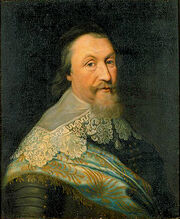| ||||||||||||||||||||||||||||
Axel Gustafsson Oxenstierna af Södermöre (/ˈʊksɛnˌʃɛrna/) (b. June 16, 1583 – d. August 28, 1654), Count of Södermöre, was a Swedish statesman. He became a member of the Privy Council in 1609 and served as Lord High Chancellor of Sweden from 1612 until his death. He was a confidant of both Gustavus Adolphus and later Queen Christina.
Oxenstierna is widely considered one of the most influential people in Swedish history. He played an important role during the Thirty Years' War and was appointed Governor-General of occupied Prussia; he also laid the foundations of Swedish central government administration.
Axel Oxenstierna in 1632[]
During the Thirty Years War, Axel Oxenstierna (b. June 16, 1583 – d. February 27, 1636) acted as Gustavus Adolphus' right hand adjutant. As such, he attempted to gently check some of his king's less temperate impulses.
In 1631, after the fall of Magdeburg to Count Tilly, Oxenstierna was the only person present who did not react when Gustav flew into a violent rage upon learning what had happened. After Gustav was calm, Oxenstierna helped the king take stock of his alliance's situation. He convinced Bernard of Saxe-Weimar not to lead a doomed defense of his lands, but to stay with Gustavus. He also reminded Gustavus that even when Tilly fell, Albrecht von Wallenstein was almost certainly waiting in the wings. Later, in private, Oxenstierna confirmed that badly needed funding from the Dutch Republic had not arrived, and tried to convince Gustavus not to blame himself for the bloody disaster at Magdeburg, to no avail.
In the months that followed after the Battle of Breitenfeld, Oxenstierna learned about the New United States that was created in the middle of southern Thuringia. When Duke Wilhelm's request for an expedition into the NUS was flatly denied by Gustavus, Oxenstierna tried to convince Gustavus to accept Wilhelm's request as he saw the enclave's revolutionary influence would spread across the German principalities and caused a panic that could disrupt their Saxe-Weimar and Hesse-Cassel allies. Gustavus instead decided to meet with the Americans.
Oxenstierna was not present for the battle at Nürnberg, nor for the Battle of Grantville. He was also not present for the initial meetings that produced the Confederated Principalities of Europe, and was horrified by how much Gustavus had conceded. However, when Gustavus shared what he knew of the future with Oxenstierna, the chancellor bowed to the king's will. Subsequent meetings with the Americans put him more at ease, though his attachment to the principles of aristocratic privilege never diminished.
After Gustavus was incapacitated by the severe head trauma he received at Lake Bledno in October of 1635, Oxenstierna saw a chance to reestablish the power of the nobility in the United States of Europe. Even though he had no official position within the USE's government, he used the presence of Swedish troops in and around Berlin to 'bully' Prime Minister Wilhelm Wettin into co-operating with him. When Prime Minister Wettin confronted him with evidence of a plot to betray Ingolstadt -- and the Upper Palatinate -- to Bavaria, Oxenstierna had Wettin arrested. He appointed Johann Wilhelm Neumair von Ramsla as the new Prime Minister even though a) he had no legal authority to do so, b) the Berlin convention had no legal authority to approve it, and c) von Ramsla was not legally qualified for the post. Arresting Wettin, especially on charges that were obviously trumped-up, was a serious blunder that cost Oxenstierna support throughout the USE, as it was seen as Swedish high-handedness. Even people who had supported Wettin and the Crown Loyalists were disinclined to support Oxenstierna once it was clear that he was the one in charge. He was also hampered by a widespread sense that he was taking actions which Gustavus would not have approved.
Oxenstierna misjudged and underestimated his opponents in the Fourth of July Party and the Committees of Correspondence. Having convinced himself that they had brought anarchy to the Germanies, he expected that chaos would erupt, and was confused and frustrated when it did not. He had apparently expected to establish legitimacy by suppressing chaos, but instead gave his opponents the opportunity to portray themselves as forces of order, stability, and legitimacy. During this time, he became known as "the Swede", a disapproving title that had previously been applied to Gustavus. At least in Magdeburg, he also became known as "The Ox" ("Der Ochse"), and was frequently caricatured as bovine.
In 1636, Oxenstierna's hopes for success hinged on Johan Banér's assault on Dresden. He was annoyed that Nils Brahe and Gustav Horn would not send troops to assist Banér. He had planned to march on - and destroy - Magdeburg, but after Banér was killed, he shifted his plans to march on Dresden. On February 27, 1636, in a tavern on the outskirts of Berlin, he was confronted by a recovered - and furious - Gustavus. When Gustavus had a seizure before Oxenstierna could be arrested, Oxenstierna was shot dead by Erik Haakansson Hand.
